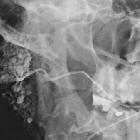Tumoren der Tränendrüse










Lacrimal gland masses can be classified into two broad groups - inflammatory (~50%) and neoplastic, either lymphoma (25%) or salivary gland type tumors (~25%).
Pathology
Inflammatory
- sarcoidosis
- affects ~25% of patients with systemic disease
- orbital inflammatory pseudotumor
- lacrimal gland is second most commonly affected orbital structure after the extraocular muscles
- Sjögren syndrome
- infectious dacryoadenitis: bacterial or viral etiology
Neoplastic
Most are epithelial in origin, with ~50% benign and ~50% malignant.
Benign epithelial tumors
These lesions are slow-growing masses more commonly found in adults in their fourth to fifth decades of life:
- lacrimal gland pleomorphic adenoma
- benign reactive lymphoid hyperplasia
- lacrimal gland oncocytoma
- dermoid cyst of the lacrimal gland
Malignant epithelial tumors
- adenoid cystic carcinoma
- most common malignant lacrimal gland tumor
- accounts for 50% of malignant tumors of lacrimal gland and 25% of all lacrimal gland tumors
- adenocarcinoma of lacrimal glands
- acinic cell carcinoma of lacrimal glands
- malignant lymphoma: lacrimal gland involvement with lymphoma
- squamous cell carcinoma
- mucoepidermoid carcinoma (rare)
Non-epithelial neoplasms
Most of these cases are seen in the third decade of life, but distribution is bimodal with an earlier peak in the teenage years.
- lymphoma
- orbital granulocytic sarcoma (a.k.a. chloroma)
- hemangioma
- solitary fibrous tumor
- metastatic or secondary tumors
- leukemia
Differential diagnosis
Other rare causes of lacrimal gland masses include tuberculosis, amyloidosis, thyroid-associated orbitopathy, granulomatosis with polyangiitis. Sickle cell disease is reported to cause lacrimal gland edema .
Extra-lacrimal masses that occur in the superolateral orbit should be considered :
Siehe auch:
- intraorbitale Raumforderungen
- Sjögren-Syndrom
- Metastasen in der Orbita
- kavernöses Hämangiom der Orbita
- Lymphom der Tränendrüse
- Adenokarzinom der Glandula lacrimalis
- Entzündungen der Glandula ladrimalis
und weiter:

 Assoziationen und Differentialdiagnosen zu Tumoren der Tränendrüse:
Assoziationen und Differentialdiagnosen zu Tumoren der Tränendrüse:




